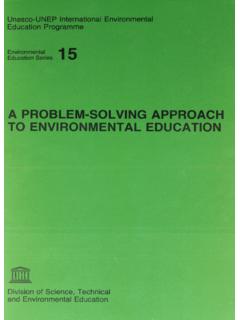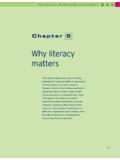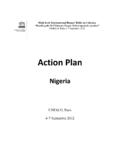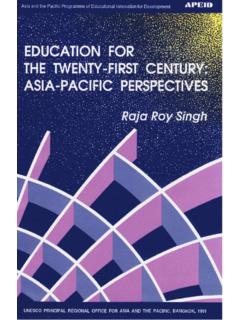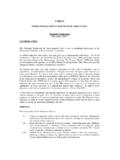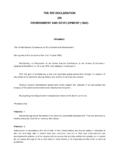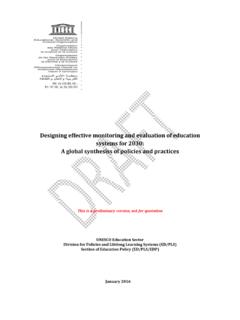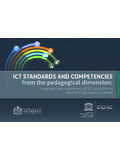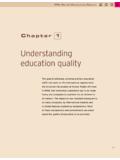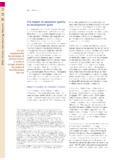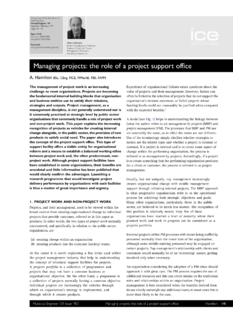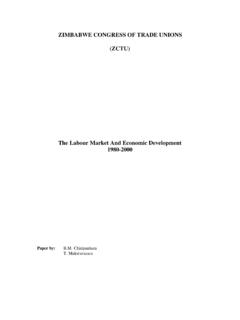Transcription of Fundarnentals of educational planning—51 - UNESCO
1 Fundarnentals of educational planning 51. Included in the series:*. 2. The relation of educational plans to economic and social planning R. Poignant 4 Planning and the educational administrator Beeby 5. The social context of educational planning Anderson 6. The costing of educational plans, J. Vaizey, J. D. Chesswas 7. The problems of rural education, Criffiths 8. educational planning; the adviser's role, A. Curle 9. Demographic aspects of educational planning, Ta Ngoc C. 10. The analysis of educational costs and expenditure, J. Hallak 11. The professional identity of the educational planner, A. Curle 12. The conditions for success in educational planning, Ruscoe 13. Cost-benefit analysis in educational planning, M. Woodhall 18. Planning educational assistance for the second development decade, Philips 20. Realistic educational planning, McKinnon 21. Planning education in relation to rural development, Coverdale 22. Alternatives and decisions in educational planning, Montgomery 23.
2 Planning the school curriculum, A. Lewy 24. Cost factors in planning educational technological systems, 25. The planner and lifelong education, P. Furter 26. Education and employment: a critical appraisal, M. Carnoy 27. Planning teacher demand and supply, P. Williams 28. Planning early childhood care and education in developing countries A. Heron 29. Communication media in education for low-income countries McAnany, Mayo 30. The planning of nonformal education, Evans 31. Education, training and the traditional sector, J. Hallak, F. Caillods 32. Higher education and employment: the IIEP experience in five less-developed countries G. Psacharopoulos, Sanyal 33. educational planning as a social process, T. Malan 34. Higher education and social stratification: an international comparative study, T. Hus n 35. A conceptual framework for the development of lifelong education in the USSR, A. Vladislavlev 36. Education in austerity: options for planners, K Lewin 37.
3 educational planning in Asia, R. Roy-Singh 38. Education projects: elaboration, financing and management, A. Magnen 39. Increasing teacher effectiveness, Anderson 40. National and school-based curriculum development, A. Lewy 41. Planning human resources: methods, experiences and pratices, O. Bertrand 42. Redefining basic education for Latin America: lessons to be learned from the Colombian Escuela Nueva, E. Schiefelbein 43. The management of distance learning systems, G. Rumble 44. educational strategies for small island states, D. Atchoarena 45. Judging educational research based on experiments and surveys, Wolf 46 Law and educational planning, I. Birch. 47. Utilizing education and human resource sector analyses, F. Kemmerer 48. Cost analysis of educational inclusion of marginalized populations Mun C. Tsang. 49. An efficiency-based management information system, Walter W. McMahon. 50. National examinations: design, procedures and reporting, John P.
4 Keeves. * Also published in French. Other titles to appear. Education policy-planning process: an applied framework Wadi D. Haddad with the assistance of Terri Demsky Paris 1995. UNESCO : International Institute for educational Planning The Swedish International Development Authority (SIDA) has provided financial assistance for the publication of this booklet. This booklet is derived from a study (The dynamics of educatio - nal policy making: case studies of Peru, Jordan, Thailand and Burkina Faso - 1994) by the same authors, prepared for and publi- shed by the Economic Development Institute of the World Bank. The findings, interpretations, and conclusions of this booklet, though, are the responsibility of the authors and should not be attributed to the World Bank or the International Institute for educational Planning. Published in 1995 by the United Nations educational , Scientific and Cultural Organization 7 place de Fontenoy, 75700, Paris Cover design by Bruno Pf ffli ISBN 92-803- 1 1 55-7.
5 UNESCO 1995 IIEP/ko'f Fundamentals of educational planning The booklets in this series are written primarily for two types of clientele: those engaged in educational planning and administration, in developing as well as developed countries; and others, less specialized, such as senior government offi- cials and policy-makers who seek a more general understanding of educational planning and of how it is related to overall national development. They are inten- ded to be of use either for private study or in formal training programmes. Since this series was launched in 1967 practices and concepts of educatio- nal planning have undergone substantial change. Many of the assumptions which underlay earlier attempts to rationalize the process of educational deve- lopment have been criticized or abandoned. Even if rigid mandatory centralized planning has now clearly proven to be inappropriate, this does not mean that all forms of planning have been dispensed with.
6 On the contrary, the need for col- lecting data, evaluating the efficiency of existing programmes, undertaking a wide range of studies, exploring the future and fostering broad debate on these bases to guide educational policy and decision making has become even more acute than before. The scope of educational planning has been broadened. In addition to the formal system of education, it is now applied to all other important educational efforts in nonformal settings. Attention to the growth and expansion of educa- tional systems is being complemented and sometimes even replaced by a gro- wing concern for the quality of the entire educational process and for the control of its results. Finally, planners and administrators have become more and more aware of the importance of implementation strategies and of the role of diffe- rent regulatory mechanisms in this respect: the choice of financing methods, the examination and certification procedures or various other regulation and incen- tive structures.
7 Tive structures. The Theconcern of planners concern is twofold: of planners to reach atobetter is twofold: reach 5. Fundamentals of educational planning understanding of the validity of education in its own empirically observed specific dimensions and to help in defining appropriate strategies for change. The purpose of these booklets includes monitoring the evolution and change in educational policies and their effect upon educational planning requirements;. highlighting current issues of educational planning and analyzing them in the context of their historical and societal setting; and disseminating methodologies of planning which can be applied in the context of both the developed and the developing countries. In order to help the Institute identify the real up-to-date issues in educational planning and policy making in different parts of the world, an Editorial Board has been appointed, composed of two general editors and associate editors from dif- ferent regions, all professionals of high repute in their own field.
8 At the first mee- ting of this new Editorial Board in January 1990, its members identified key topics to be covered in the coming issues under the following headings: 1. Education and development 2. Equity considerations 3. Quality of education 4. Structure, administration and management of education 5. Curriculum 6. Cost and financing of education 7. Planning techniques and approaches 8. Information systems, monitoring and evaluation Each heading is covered by one or two associate editors. The series has been carefully planned but no attempt has been made to avoid differences or even contradictions in the views expressed by the authors. The Institute itself does not wish to impose any official doctrine. Thus, while the views are the responsibility of the authors and may not always be shared by UNESCO or the IIEP, they warrant attention in the international forum of ideas. Indeed, one of the purposes of this series is to reflect a diversity of experience and opinions by giving different authors from a wide range of backgrounds and dis- ciplines the opportunity of expressing their views on changing theories and prac- tices in educational planning.
9 The present booklet is concerned with educational policy making. educational planning and educational policy making are closely intercon- nected. Planners who do not understand how policies are forrnulated are not ensured of success; neither can they be of great help to policy-makers. 6. Fundamentals of educational planning Indeed, planning entails a variety of processes, from the analysis of the present situation, the generation and assessment of policy options, to the careful prepara- tion and monitoring of policy implementation, eventually leading to the redefini- tion of a new policy cycle. A variety of players intervene in these processes and if their interests are not carefully assessed and taken care of, then the policy or the plan will have every chance of failing. educational history is full of reforms and plans which were never implemented precisely because the interests of cer- tain key actors (parents or teachers) had not been taken into consideration, finan- cial and human resources implications had not been carefully assessed or the sys- tem's managerial capacity had not systematically been taken into account.
10 The contents of the present booklet, which was written by Wadi Haddad with the assistance of Terri Demsky, contain an integrated model of educational deci- sion making, illustrated by some four critically analyzed country case studies. The authors draw some lessons for the attention of educational planners. No one but Wadi Haddad, who was Chief Adviser to the President of Lebanon, the Executive Secretary of the World Conference on Education for All, and who is now Deputy Secretary of the World Bank, would have been in a better position to present this important topic. Indeed, Aid agencies are now amongst the most powerful players in the deci- sion-making process in many developing countries. As the case studies in this booklet illustrate, they have not always exercised their respective influential posi- tion in the best possible way. This booklet should definitely interest planners, decision-makers but also those donors who want to see educational change taking place with the good of the countries in mind.
